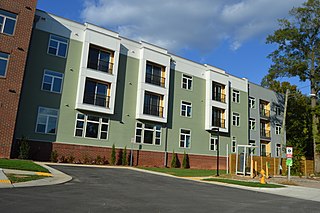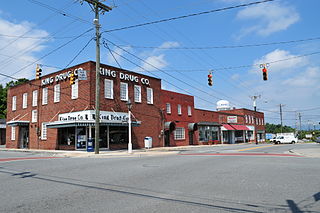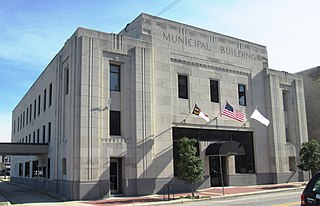
The Maiden Lane Historic District is a national historic district located at Raleigh, North Carolina. The district encompasses 12 contributing residential buildings and was developed between about 1893 and 1923. The district includes notable examples of Queen Anne and Colonial Revival style architecture. Notable houses include the Isabella Morrison Hill House, Irby-Brewer House, Allie H. Kirks House, Love Virginia Davis House, and Frank Brown House (1923).

Boxwood Lodge is a historic hunting retreat and national historic district located near Mocksville, Davie County, North Carolina. The district encompasses 8 contributing buildings, 1 contributing site, and 4 contributing structures on a rural estate including a manor house. It was developed between 1911 and 1931 by William Rabb Craig (1870-1931), a wealthy cotton and sugar broker. The manor house was built between 1933 and 1934, and is a two-story, "H"-plan, brick Colonial Revival dwelling designed by the architectural firm Delano & Aldrich. Other notable resources include the grounds of Boxwood Lodge, greenhouse, log cabin, great barn (1910s), feed / grain house, and entrance piers (1934).

Upper Town Creek Rural Historic District is a national historic district located near Wilson, in Edgecombe and Wilson County, North Carolina. The district encompasses 117 contributing buildings and 2 contributing structures on four contiguous farms near Wilson. The main plantation house on each farm are the Federal-style W. D. Petway House ; the Greek Revival house built for Colonel David Williams ; the house built for Cally S. Braswell ; and the board and batten Gothic Revival Jesse Norris House. The remaining contributing building and structures include packhouses, tobacco barns, tenant houses, and other agricultural outbuildings.

Raeford Historic District is a national historic district located at Raeford, Hoke County, North Carolina. The district encompasses 48 contributing buildings and two contributing structures in the central business district of Raeford. The commercial and institutional buildings, residences, and transportation-related resources include notable examples of Queen Anne- and Colonial Revival-style architecture built after 1897. Notable buildings include the B. R. and Margaret Gatlin House, J.W. and Christina McLauchlin House, Raeford Furniture Company, Hoke Drug, Bank of Raeford (1911), Aberdeen & Rockfish Railroad Passenger Depot, Johnson-Thomas Building, and Davis Sinclair Station.

Mitchell College Historic District is a national historic district located at Statesville, Iredell County, North Carolina. It encompasses 336 contributing buildings and 1 contributing site associated with Mitchell Community College and the surrounding residential area in Statesville. The district includes notable examples of Greek Revival, Queen Anne, and Classical Revival architecture dated between about 1885 and 1930. Located in the district is the oldest building and separately listed; the Main Building, Mitchell College (1854-1856). Other notable contributing resources are the Fourth Creek Burying Ground, George Anderson House, Friends Meeting House, Broad St. Methodist Church (1907), Congregation Emmanuel Synagogue (1891), McRorie House, Dr. Tom H. Anderson House, Dr. Julius Lowenstein House, Ludwig Ash House, L. N. Mills House (1925), Mills Apartment, R. A. Cooper House (1920), Statesville Woman's Club (1927), and the former Davis Hospital.

Everetts Historic District is a national historic district located at Everetts, Martin County, North Carolina. The district encompasses 84 contributing buildings, 3 contributing sites, and 1 contributing structure in the town of Everetts. They include notable examples of Queen Anne, Colonial Revival, Romanesque, and Bungalow / American Craftsman architecture in buildings dated from the 1870s through the 1950s. Most of the district's extant historic buildings date from the early 1900s and 1910s. Located in the district is the separately listed Everetts Christian Church. Other notable buildings include the Simon Peter and Minerva Jane Everett House (1870s), Peel House, Barnhill's Hardware and Grocery Store (1907), the J. S. Peel Commercial Building (1909), Taylor-Peel House, and the Everetts Community Building (1952).

Eugene Wilson Hodges Farm is a historic home, farm, and national historic district located near Charlotte, Mecklenburg County, North Carolina. The district encompasses four contributing buildings, one contributing site, and five contributing structures in rural Mecklenburg County. The Eugene Wilson Hodges House was built about 1908, and is a two-story, three-bay I-house with two parallel one-story rear ells. It has a slate triple-A roof and two exterior, stuccoed-brick chimneys. It features a vernacular Colonial Revival hip roofed wraparound front porch with Doric order columns. Other contributing resources include two chicken coops, a wellhouse, barn, two granaries, two silos, and the agricultural landscape.

Seaboard Historic District is a national historic district located at Seaboard, Northampton County, North Carolina. The district encompasses 107 contributing buildings, 1 contributing site, and 4 contributing structures in the central business district and surrounding residential sections of Seaboard. The district developed between about 1874 and 1955 and includes notable examples of Queen Anne and Colonial Revival style architecture. Notable contributing resources include the Edwards Warehouse, Bradley Howell Peanut Drying and Storage Facility, Sidney S. Harris Gas Station, Stephenson-Barbee House, Edwards House, Seaboard United Methodist Church, Bethlehem Baptist Church, and Seaboard School (1927).

Catherine Lake Historic District is a national historic district located at Catherine Lake, Onslow County, North Carolina. The district encompasses eight contributing buildings in the mid- to late-19th century community of Catherine Lake. The district developed between about 1850 and 1900 and includes notable examples of Greek Revival and Italianate style architecture. Notable contributing buildings include the John A. Avirett house, the Jay Franklin Boggs House, and the Rodolph Duffy house (1896).

Belvidere Historic District is a national historic district located at Belvidere, near Hertford, Perquimans County, North Carolina. The district encompasses 68 contributing buildings, 3 contributing sites, and 6 contributing structures in the rural agricultural area around the village of Belvidere. The district developed between about 1800 and 1949, and includes notable examples of Federal and Greek Revival style architecture. Notable buildings include the Joseph Smith House, Rufus White House, Edwin S. White Farm, Fernando C. White Mill Complex, John J. Chappell, Jr. Farm, and Murray and Fernando C. White Farm.

Old Neck Historic District is a national historic district located at Belvidere, near Hertford, Perquimans County, North Carolina. The district encompasses 44 contributing buildings, 5 contributing sites, 12 contributing structures, and 1 contributing object in a rural agricultural area near Hertford. The district developed between about 1813 and 1946, and includes notable examples of Federal and Greek Revival, and Colonial Revival style architecture. Located in the district are the separately listed Fletcher-Skinner-Nixon Plantation and Cove Grove Plantation. Other notable buildings include the Francis Nixon Plantation, William Jones Plantation, Thomas Nixon Plantation, Winslow Farm, John Newbold Farm, and Matthew Towe Farm.

Renston Rural Historic District is a national historic district located near Winterville, Pitt County, North Carolina. The district encompasses 105 contributing buildings, 6 contributing sites, 7 contributing structures, and 1 contributing object on eight major farms in rural Pitt County near Winterville. It includes buildings largely dated from about 1890 to 1953 and notable examples of Greek Revival and Classical Revival style architecture. They include the Fletcher Farm, the Charles and Maggie McLawhorn farms, the Langston-Edwards properties, the Dail Farm, the Dennis McLawhorn farms, the McLawhorn-Abbott property, and the Richard Herman McLawhorn farms. Notable individual buildings include the Joseph Smith House, former Renston School and the first Bethany Free Will Baptist Church, Spier Worthington House, Langston-Edwards House, the Dail House, and the Charles McLawhorn House.

King Historic District is a national historic district located at King, Stokes County, North Carolina. The district encompasses 72 contributing buildings and 1 contributing structure in the central business district and surrounding residential sections of King. They were built between about 1914 to the 1950s and include notable examples of Colonial Revival and Bungalow / American Craftsman architecture. Notable buildings include the Bank of King, King Drug Company, Simeon Wesley Pulliam House, James Robert Hutchins House, King Milling Company, and King Moravian Church.

Carpenter Historic District is a national historic district located near Cary, Wake County, North Carolina. The districts encompasses 66 contributing buildings, 1 contributing site, and 8 contributing structures in the rural crossroads community of Carpenter. The district developed between about 1895 and 1933, and includes notable examples of Late Victorian and Colonial Revival style architecture. Notable buildings include the Carpenter Farm Supply Company, D. Judson Clark Machine/Garage, Byrd-Ferrell House, Mallie and Cora Butts Farm, A.M. Howard Farm, and Barbee-Williams Farm.

Jones–Johnson–Ballentine Historic District is a national historic district located near Fuquay-Varina, Wake County, North Carolina. The district encompasses 18 contributing buildings, 3 contributing sites, and 8 contributing structures on the Johnson Farm and the Ballentine Farm near Fuquay-Varina. The district includes notable examples of Classical Revival and Victorian style architecture. Notable resources include the William Wesley Johnson House, The Log Cabin, James E. Ballentine House (1890), The Creamery, Dairy Barn (1915), a family cemetery and the surrounding farm landscape.

Mordecai Place Historic District is a historic neighborhood and national historic district located at Raleigh, North Carolina. The district encompasses 182 contributing buildings and 1 contributing object in the most architecturally varied of Raleigh's early-20th century suburbs for the white middle-class. Mordecai Place was listed on the National Register of Historic Places in February 1998, with a boundary increase in 2000.

Black Creek Rural Historic District is a national historic district located near Black Creek, Wilson County, North Carolina. It encompasses 68 contributing buildings in a rural area near Black Creek. The district developed after 1787 and includes notable examples of Federal, Georgian, and Greek Revival style architecture. Notable buildings include the Shadrack Dickinson House (1787), Dr. Brooks House, John Woodard House, Stephen Woodard House, and Dr. Stephen Woodard House.

Elm City Municipal Historic District is a national historic district located at Elm City, Wilson County, North Carolina. It encompasses 85 contributing buildings in the railroad town of Lucama. The district developed between about 1873 to 1930 and includes notable examples of Classical Revival, Early Commercial, and Victorian style architecture. Notable buildings include the Batts & Williams Store (1884), G. A. Barnes Store (1912), Dawes Building (1914), Elm City Bank (1920s), Holden House, A. C. Dixon House, G. A. Barnes House, W. G. Sharpe House, Dr. Robert Putney, Sr., House, and L. C. Cobb House (1927).

West Nash Street Historic District is a national historic district located at Wilson, Wilson County, North Carolina. It encompasses 79 contributing buildings in a predominantly residential section of Wilson. The district largely developed during the 1910s and 1920s and includes notable examples of Colonial Revival and Bungalow / American Craftsman style architecture. Notable buildings include the William W. Graves House, Selby Hurt· Anderson House, Williams-Cozart House, John T. Barnes House, Graham-Woodard House, M. Douglas Aycock House (1925-1928), John D. Gold House, Boykin's Filling Station, and West End Grocery.

The Wilson Central Business–Tobacco Warehouse District is a national historic district located at Wilson, Wilson County, North Carolina. It encompasses 152 contributing buildings, 20 contributing sites, and 2 contributing structures in the central business district of Wilson. The district includes notable examples of Late Victorian and Art Deco style architecture. Located in the district are the separately listed Branch Banking Building, Cherry Hotel, and Wilson County Courthouse. Other notable buildings include the Woodard-Watson Warehouse, Planter's Warehouse, Passenger Station and Freight Depot (1924), Jackson Chapel First Baptist Church (1913), St. John's African Methodist Episcopal Church (1915), Imperial Tobacco Company, Winstead-Hardy Building, Rountree Building (1870s), Planter's Bank Building (1920), United States Post Office and Courthouse (1927), Charles L. Coon High School (1922), First National Bank of Wilson Building (1927), Wilson Theatre (1922), Odd Fellows Lodge (1896), and the Works Projects Administration financed Wilson Municipal Building (1938).












